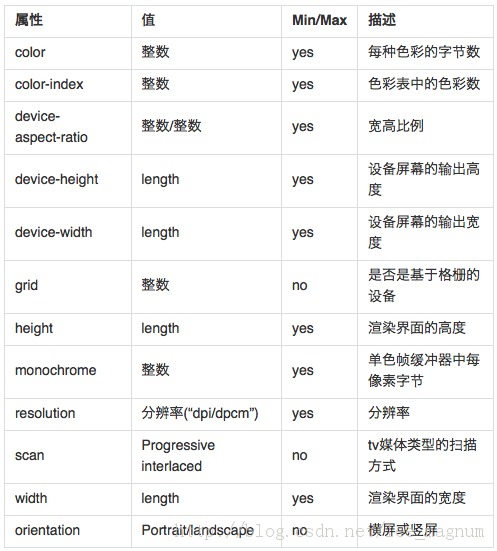Media Queries是CSS3有关媒体查询的属性,有了CSS3 之媒体查询Media Queries就可以进行媒体查询,针对每个不同的媒体进行不同的样式编写。传说中的Web响应式布局就可以毫无压力的做出来了。下面我们就一起来看看CSS3 之媒体查询Media Queries的相关知识吧。
一、Media Query之引入方法
1、外部引用
<link rel="stylesheet" type="text/css" href="../css/print.css" media="print" />
2、@media引入
@media screen{
选择器{
属性:属性值;
}
}
3、xml方式引入
<?xml-stylesheet rel="stylesheet" media="screen" href="css/style.css" ?>
4、@import方式引入
@import url("css/reset.css") screen;
@import url("css/print.css") print;
二、Media Query的Media中的值

三、Media Query之兼容情况

四、Media Query之实例
1、最大宽度Max Width――当屏幕小于或等于600px时,将采用small.css样式来渲染Web页面
<link rel="stylesheet" media="screen and (max-width:600px)" href="small.css" type="text/css" />
2、最小宽度Min Width――当屏幕大于或等于900px时,将采用big.css样式来渲染Web页面
<link rel="stylesheet" media="screen and (min-width:900px)" href="big.css" type="text/css" />
3、多个Media Queries――当屏幕在600px-900px之间时采用style.css样式来渲染web页面
<link rel="stylesheet" media="screen and (min-width:600px) and (max-width:900px)" href="style.css" type="text/css" />
4、设备屏幕的输出宽度Device Width――iphone.css样式适用于最大设备宽度为480px,比如说iPhone上的显示,这里的max-device-width所指的是设备的实际分辨率,也就是指可视面积分辨率
<link rel="stylesheet" media="screen and (max-device-width: 480px)" href="iphone.css" type="text/css" />
5、iPhone4
<link rel="stylesheet" media="only screen and (-webkit-min-device-pixel-ratio: 2)" type="text/css" href="iphone4.css" />
6、iPad――在纵向(portrait)时采用portrait.css来渲染页面;在横向(landscape)时采用landscape.css来渲染页面
<link rel="stylesheet" media="all and (orientation:portrait)" href="portrait.css" type="text/css" /> <link rel="stylesheet" media="all and (orientation:landscape)" href="landscape.css" type="text/css" />
7、Android
<!--240px的宽度--> <link rel="stylesheet" media="only screen and (max-device-width:240px)" href="android240.css" type="text/css" /> <!--360px的宽度--> <link rel="stylesheet" media="only screen and (min-device-width:241px) and (max-device-width:360px)" href="android360.css" type="text/css" /> <!--480px的宽度--> <link rel="stylesheet" media="only screen and (min-device-width:361px) and (max-device-width:480px)" href="android480.css" type="text/css" />
8、not关键字――排除某种制定的媒体类型
<link rel="stylesheet" media="not print and (max-width: 1200px)" href="print.css" type="text/css" />
9、only关键字
only用来定某种特定的媒体类型,可以用来排除不支持媒体查询的浏览器。其实only很多时候是用来对那些不支持Media Query但却支持Media Type的设备隐藏样式表的。其主要有:支持媒体特性(Media Queries)的设备,正常调用样式,此时就当only不存在;对于不支持媒体特性(Media Queries)但又支持媒体类型(Media Type)的设备,这样就会不读了样式,因为其先读only而不是screen;另外不支持Media Qqueries的浏览器,不论是否支持only,样式都不会被采用。
<link rel="stylesheet" media="only screen and (max-device-width:240px)" href="android240.css" type="text/css" />
10、逗号――style.css样式被用在宽度小于或等于480px的手持设备上,或者被用于屏幕宽度大于或等于960px的设备上
<link rel="stylesheet" type="text/css" href="style.css" media="handheld and (max-width:480px), screen and (min-width:960px)" />
11、禁止屏幕缩放
在移动设备浏览器上,通过为viewport meta标签添加user-scalable=no可以禁用其缩放(zooming)功能。这样禁用缩放功能后,用户只能滚动屏幕,就能让你的网站看上去更像原生应用的感觉。注意,这种方式我们并不推荐所有网站使用,还是要看你自己的情况而定!
<meta name="viewport" content="width=device-width, initial-scale=1.0, maximum-scale=1.0, user-scalable=no">
CSS3 之媒体查询Media Query的介绍就在上面了,希望大家看过之后,非常轻松的能够掌握媒体查询这个小小的CSS3属性。